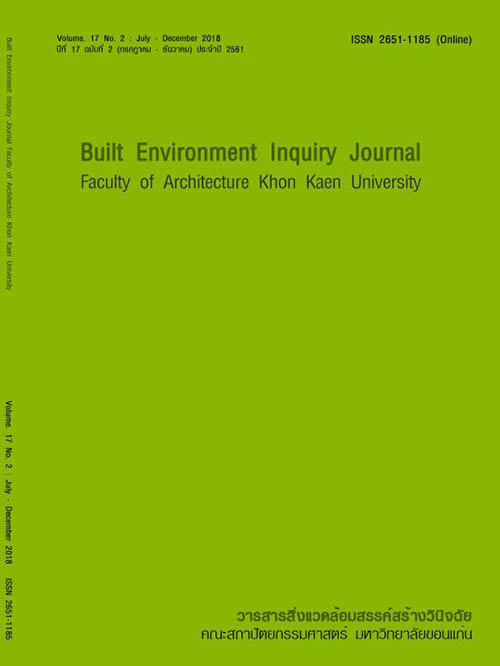บทบาทของนักผังเมืองกับการมีส่วนร่วมในกระบวนการวางผังของผู้มีส่วนได้ส่วนเสีย
คำสำคัญ:
Planning school, involvement of stakeholders, participatory planning, planning theoriesบทคัดย่อ
This paper addresses the competitive role of urban planner and stakeholder involvement in the urban planning process. In doing so, this paper presents that the significance and level of stakeholder involvement in the planning process are majorly determined by the planner and the nature of the planning model being taken. During physical and design-based view, as an absolute centralized regime, the professional planner could best know what sorts of unfit or fit physical environments for the living of people. As result, no stakeholder involvement was addressed in the planning process. On the other hand, since the early 1960s, community participation and stakeholder involvement were first noticed in the systems and rational process views of planning. Though the urban planners also played a key role as a helmsman of the growing multitude of parties, the planners were acknowledged as the objective policy analyst and professional planners. With the dominant view of the professional planner, the stakeholder involvement was acknowledged as tokenism level since stakeholder was consulted rather than involved in the process of decision-making. From the 1970s onwards, the growth of bottom-up, people-led participatory development together with the integration of social, economic and environmental issues in the planning forced the planners to involve and encourage all stakeholders with broadening the range of actors to participate in decision-making in processes of urban planning. Accordingly, the stakeholders have more opportunities to take parts in co-designing, co-decision-making, and even decision-making. At the same time, the planners have turned themselves from profession planners to decentralized planners such as political arbiters between different interests. Currently, the planners are required to have their own professional skill and other additional skills such as communicative, negotiate, facilitating skill etc. for coping with the movement of stakeholder involvement in the planning process. The paper thus contributes to the need for additional roles of urban planners in terms of the contemporaneous complex decision-making in relation to stakeholder involvement in the planning process.
เอกสารอ้างอิง
Allmendinger, P. (2002). Planning Theory. Palgrave Macmillan.
Beck, U. (1992). Risk society: Towards a new modernity (Vol. 17). Sage.
Bureau of Labor Statistics, U.S. Department of Labor. (2000). Occupational Outlook Handbook, 2000-1 Edition, Bulletin 2520. Superintended of Documents, U.S. Government Printing Office, Washington, DC
Bureau of Labor Statistics, U.S. Department of Labor. (2010). Occupational Outlook Handbook, 2010-11 Edition, Bulletin 2520. Superintended of Documents, U.S. Government Printing Office, Washington, DC
Cerar, A. (2014). From reaction to initiative: Potentials of contributive participation. Urbani izziv, 25(1), 93-106.
CollegeGrad (n.d). Urban and Regional Planner: Career, Salary and Education Information. Retrieved 24 March, 2018, from https://collegegrad.com/careers/urban-and-regional-planners
Davidoff, P. (1965). Advocacy and pluralism in planning. Journal of the American Institute of planners, 31(4), 331-338.
Davies, S. R., Selin, C., Gano, G., & Pereira, Â. G. (2012). Citizen engagement and urban change: Three case studies of material deliberation. Cities, 29(6), 351-357.
Department for International Development (DFID). (2003). Tools for Development: A handbook for those engaged in development activity.Version 15.1
Dorcey, A.J. (1986). Bargaining in the governance of Pacific Coastal Resources: Research and Reform, Westwater Research Centre, Vancouver.
Drake, H. A. (2002). Constantine and the bishops: the politics of intolerance. JHU Press.
Fainstein, Susan S & Campbell, Scott, 1958- (2003). Readings in planning theory (2nd ed). Blackwell, Malden, Mass. ; Oxford
Faludi, A. (1985). A decision-centred view of environmental planning. Landscape Planning, 12(3), 239-256.
Friedmann, J. (1973). Retracking America: A Theory of Transactive Planning. Garden City, NJ: Anchor Press/Doubleday.
Friedmann, J. (1978). The epistemology of social practice. Theory and society, 6(1), 75-92.
Great Britain., Fifth Framework Programme (European Commission), & GUIDEMAPS Consortium. (2004). Successful transport decision-making: A project management and stakeholder engagement handbook. Aachen, Germany?: GUIDEMAPS Consortium. Retrieved 21 November, 2016, from https://civitas.eu/sites/default/files/guidemapshandbook_web.pdf
Guidemaps. (2004). Successful Transportation Decision-Making: A project management and stakeholder engagement handbook. Retrieved 21 November, 2016, from https://civitas.eu/sites/default/files/guidemapshandbook_web.pdf
Habermas, J. (1984). The Theory of Communicative Action 1, Reason and the Rationalization of Society. 1984. Polity, Cambridge.
Hall, P. (1983). The Anglo-American connection: Rival rationalities in planning theory and practice, 1955–1980. Environment and Planning B: Planning and Design, 10(1), 41-46.
Healey, P. (1997). Collaborative planning: Shaping places in fragmented societies. UBc Press.
Healey, P., McDougall, G.,& Thomas, M. J. (Eds.). (1982) Planning Theory: Prospects for the 1980s: Selected Papers from a Conference Held in Oxford, 2-4 April 1981 (Vol. 29). Pergamon.
Hudson, B. M., Galloway, T. D., & Kaufman, J. L. (1979). Comparison of current planning theories: Counterparts and contradictions. Journal of the American Planning Association, 45(4), 387-398.
Kiernan, M. J. (1983). Ideology, politics and planning: reflections on the theory and practice of urban planning. Environment and Planning B: Planning and Design, 10(1), 71-87.
Kumar, A., & Paddison, R. (2000). Trust and collaborative planning theory: The case of the Scottish planning system. International Planning Studies, 5(2), 205-223.
Lane, M. B. (2005). Public participation in planning: an intellectual history. Australian Geographer, 36(3), 283-299.
Lefevre, P., Kolsteren, P., De Wael, M. P., Byekwaso, F., &Beghin, I. (2001). Comprehensive participatory planning and evaluation (CPPE).
Lew, A. A. (2007). Invited commentary: Tourism planning and traditional urban planning theory—the planner as an agent of social change. Leisure/Loisir, 31(2), 383-391.
Lindblom, C. E. (1959). The science of" muddling through". Public administration review, 79-88.
Low, N. (1991). Planning, Politics and the State: Political Foundations of Planning Thought. Unwin Hyman, London.
Mallery, C., Ganachari, D., Smeeding, L., Fernandez, J., Lavallee, D., Siegel, J., ... & Moon, M. (2012). PHP5 Innovative Methods for Stakeholder Engagement: An Environmental Scan. Value in Health, 15(4), A14.
Mayers, J. (2005). Stakeholder power analysis. International Institute for Environment and Development.
McDonald, G. T. (1989). Rural land use planning decisions by bargaining. Journal of Rural Studies, 5(4), 325-335.
McLoughlin, B. (1969). Urban and Regional Planning: A Systems Approach, Lonlon: Faber and Faber.
McTague, C., &Jakubowski, S. (2013). Marching to the beat of a silent drum: Wasted consensus-building and failed neighborhood participatory planning. Applied Geography, 44, 182-191.
Miller, J. (2009). Cambridge Advanced Learners Dictionary, Third Edition [Book Review] [online]. TESOL in Context, Vol. 19, No. 2.
Monastyrski T. (2002). Citizen Participation Handbook: People’s voice project international centre for pokicy studies. "iMedia" Ltd. Kyiv, Ukraine.
Ngah, I. (1998). Urban planning a conceptual framework. Jurnal Alam Bina Jilidno, 1.
Planning Tank (2015). Rational Planning Model. Retrieved 17 October, 2016 from https://planningtank.com/planning-theory/rational-planning-model
Sager, T. (2005). Communicative planners as naїve mandarins of the neo-liberal State?. European Journal of Spatial Development-https://www. nordregio. se/EJSD/-ISSN, 1650, 9544.
Stouten, P. (2012). The new Charter of Athens: Towards sustainable neighbourhoods?. Built Environment, 38(4), 497-507.
Taylor, N (1998). Urban Planning Theory Since 1945, London: Sage.
The National Academies Press (n.d). Analytical Method and Approaches for Water Resourcees Project Planning (2004): Chapter 4 Stakeholder Participation. Retrieved 25 March, 2018, from https://www.nap.edu/read/10973/chapter/6
UK Essays, (2015). How To Build And Maintain Stakeholder Relationships Management Essay. Retrieved 20 November, 2016, from https://www.ukessays.com/essays/management/how-to-build-and-maintain-stakeholder-relationships-management-essay.php?cref=1
Yee S. (2010). Stakeholder Engagement and Public Participation in Environmental Flows and River Health Assessment. Australia-China Environment Development Partnership River Health and Environmental Flow in China.
ดาวน์โหลด
เผยแพร่แล้ว
รูปแบบการอ้างอิง
ฉบับ
ประเภทบทความ
สัญญาอนุญาต
ทัศนะและข้อคิดเห็นของบทความที่ปรากฏในวารสารฉบับนี้เป็นของผู้เขียนแต่ละท่าน ไม่ถือว่าเป็นทัศนะและความรับผิดชอบของกองบรรณาธิการ




